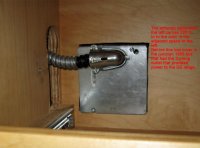Baumgrenze
Member
For most of 20 years we cooked and baked in our kitchen using the 1950's 40 inch GE Liberator 2-oven range that came with the house when we purchased it. That range had a 3-prong plug on a heavy cord and there was a matching socket mounted on the junction box wired at 220V. If the stove needed to be moved, it could be unplugged and reconnected easily. During the months of construction our remodel involved this was a daily ritual performed by the construction crew.
When remodeled our kitchen 'it was time' to discard the old and install a new, modern wall oven. Its power cord required that it be 'hard wired' to the wiring in the junction box.
Is this wiring arrangement for the convenience of the manufacturer, or is it required by changes in the uniform electrical code?
I ask because it is clear to me that modern wall ovens need maintenance. Oven maintenance frequently requires that the oven be disconnected and pulled at least part way out of the wall. I know enough about the metallurgy of copper wiring to know that it work hardens easily. This means that every disconnection/reconnection makes the following one more difficult as the terminal ends of the wires harden. The wires are also harder to stuff back into the junction box.
Does the current code permit the use of the plug/socket arrangement of the 1950's? If it does, it makes sense to me that it would be wise to implement it.
thanks,
baumgrenze
When remodeled our kitchen 'it was time' to discard the old and install a new, modern wall oven. Its power cord required that it be 'hard wired' to the wiring in the junction box.
Is this wiring arrangement for the convenience of the manufacturer, or is it required by changes in the uniform electrical code?
I ask because it is clear to me that modern wall ovens need maintenance. Oven maintenance frequently requires that the oven be disconnected and pulled at least part way out of the wall. I know enough about the metallurgy of copper wiring to know that it work hardens easily. This means that every disconnection/reconnection makes the following one more difficult as the terminal ends of the wires harden. The wires are also harder to stuff back into the junction box.
Does the current code permit the use of the plug/socket arrangement of the 1950's? If it does, it makes sense to me that it would be wise to implement it.
thanks,
baumgrenze


